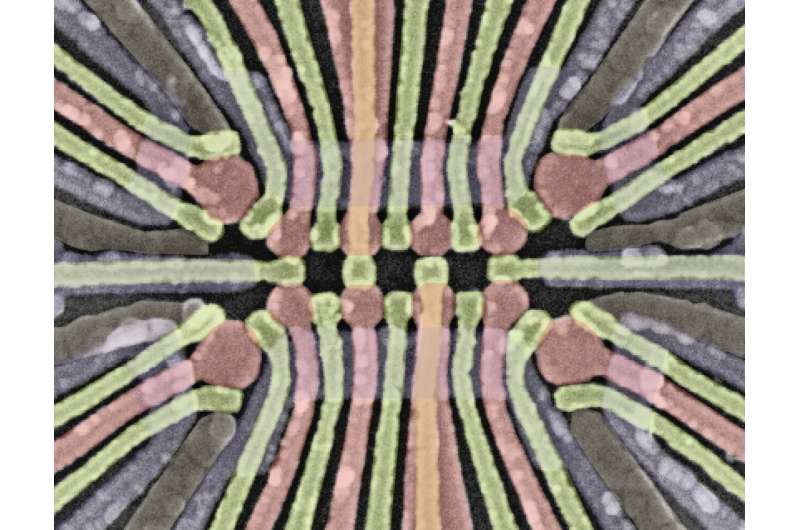
November 13, 2024 by Ingrid Fadelli , Phys.org
Collected at: https://phys.org/news/2024-11-universal-quantum-dot-based-singlet.html
Being able to precisely manipulate interacting spins in quantum systems is of key importance for the development of reliable and highly performing quantum computers. This has proven to be particularly challenging for nanoscale systems with many spins that are based on quantum dots (i.e., tiny semiconductor devices).
Researchers at Delft University of Technology (TU Delft) recently demonstrated the universal control of a quantum dot-based system with four singlet-triplet qubits. Their paper, published in Nature Nanotechnology, could open new possibilities for the successful upscaling of quantum information processing systems.
“We were initially trying to tune up and calibrate the exchange interaction between all the neighboring spins in a 4×2 quantum dot array, loaded with one spin per dot,” Lieven Vandersypen, senior author of the paper, told Phys.org.
“We used time domain measurements to do this, and at some point, we realized that we effectively achieved universal control of four so-called singlet-triplet qubits (joint states of two spins). We next made a great effort to carefully benchmark the quantum operations and to create entanglement across the qubit array.”
Before this study, quantum physicists and engineers had been able to attain universal control of systems with up to two interacting singlet-triplet qubits. Vandersypen and his colleagues were thus the first to achieve control over a larger quantum dot-based system with four singlet-triplet qubits.
“Each qubit in our system consists of two spins and single-qubit operations can be controlled by baseband voltage pulses,” explained Vandersypen. “These toggle the spin-spin exchange interaction between two different values, corresponding to two different qubit rotation axes. For two-qubit gates, we activate the exchange coupling between spins belonging to different qubits, also using gate voltage pulses.”

The researchers’ system is comprised of a 2 x 4 array of germanium quantum dots, forming a quantum dot ladder. By controlling the exchange interaction between each pair of spins along the rungs of this ladder, they initially mapped out the system’s qubit energy spectrum.
The team subsequently realized universal control of each qubit in their system by pulsing both the detuning and tunneling barriers of the corresponding double quantum dot. By concurrently controlling these two barriers of neighboring qubits, they ultimately attained a quantum gate that swaps information between qubits in a pair (i.e., two-qubit SWAP-style gate).
“When operating this device, all eight spins participate in the quantum coherent time evolution, which is the most so far in semiconductor quantum dot arrays,” added Vandersypen. “Our findings also highlight the potential of the singlet-triplet qubit. While the single-qubit operations are already quite reliable, with a fidelity above 99%, a crucial next step would be to show that the two-qubit gate can also be performed with a fidelity above 99%.”
This recent work by Vandersypen and his colleagues introduces a promising approach for attaining universal control of germanium quantum dot-based systems with four singlet-triplet qubits. In the future, this method could be improved further to precisely manipulate even larger nanoscale quantum systems.
The precise manipulation of these systems could allow physicists to reliably simulate complex physical phenomena, including quantum magnetism. In addition, it could inform the development of more advanced quantum information systems.
More information: Xin Zhang et al, Universal control of four singlet–triplet qubits, Nature Nanotechnology (2024). DOI: 10.1038/s41565-024-01817-9
Journal information: Nature Nanotechnology

Leave a Reply